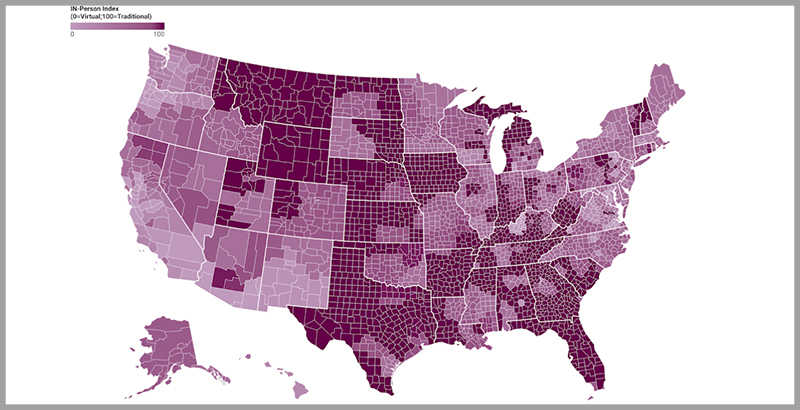74 Interview: Burbio Founder On Becoming the Go-To Source on School Reopenings Nationally and Why Summer School is the Next Thing to Track

This conversation is the latest in our ongoing series of in-depth 74 Interviews (scan our full archive). Other notable recent interviews: Former Sen. Lamar Alexander talks about finally fixing the college financial aid form, researcher Angela Duckworth talks parenting, psychology and grit, and Rhode Island Governor Dan McKee reviews a community-based afterschool program that can help combat learning loss.
A year ago when the pandemic struck, almost every one of America’s 13,000 school districts abruptly shut down. As time wore on, a crucial obstacle arose: with those districts making separate decisions about when and how to reopen, how were stakeholders supposed to know whether students were learning in person, remotely or through a mixture of both?
Enter Dennis Roche, unlikely education data hero of the pandemic.

With his wife, Roche runs Burbio, a website that helps users find community events in their area. Though the company did not begin as a school reopening tracker, they pivoted quickly last summer to begin gauging how many schools nationwide were offering in-person learning — a task that quickly proved herculean.
“We’ve literally checked these districts tens of thousands of times. We’ve watched hundreds of thousands of hours of video, we’ve read thousands of superintendent letters,” said Roche, explaining their methods.
But the hours paid off. Burbio soon became an indispensable resource for understanding the country-wide school reopening landscape. The Washington Post, Politico and the New York Times all regularly cite figures from the website, whose name is a play on the word “suburb,” in stories on schools.
As vaccinations roll out, and as more and more schools begin to welcome students back to classrooms, Roche, from his home in Pelham, New York, offered a behind-the-scenes look at what it takes to measure reopenings countrywide, while reflecting on the trends education has seen through this unprecedented crisis and what’s on the horizon.
The following interview has been edited for length and clarity:
The 74: Could you tell me what the concept was behind Burbio when it launched? Clearly, it wasn’t about COVID school reopenings.
Roche: Burbio is a six-year-old company, and it was founded by my wife and I. We have four children and it started as a way to better keep track of local community and school events. The problem we were trying to solve is: Why is it so hard to keep track of what’s going on in the community?
And so my wife was a math major, and she said, ‘Well, I’m going to try and figure out how to solve it.’ So she built our technology. …. Burbio currently streams 200,000 school, government, library and nonprofit community calendars from all 50 states and it’s dynamically up to date.
When we were building out our content, we had to go and find these websites. We had to understand the difference between a Lions Club and a Kiwanis Club. We needed to understand the difference between a charter school district, which is really maybe just a school, and an actual school district that has dozens of schools.
So that was our culture at the time when COVID hit, we were an information service — and we still are.
When the pandemic hit, this question of in-person versus remote or hybrid learning emerged nationwide, and was a huge question. The Trump administration wasn’t tracking that data. So how did you realize that Burbio might be able to fill that gap?
When COVID hit, all community events stopped. The libraries, the nonprofits, the non-school stuff stopped and all the school stuff went virtual.
For Burbio, we had to rethink immediately what problem we were now solving … We had a one-week period where a lot of things that were on some of our calendars weren’t accurate. So we started to say, ‘How can we be more helpful and what in this world can we do?’
We have 80,000 K-12 school calendars representing probably about 90 percent of all the students that are on our service. Well, if you work with suppliers, if you’re trying to sell food to that industry, that information could be interesting, right? COVID put that to the front of the line.
In the middle of July, when it became clear [that some schools wouldn’t reopen], we were racing. Every day, we would come in and we were just trying to reinvent ourselves. … We started breaking down America into counties. There’s a little over 3,000. The top 460 biggest [counties] make up 75 percent of the United States — the people, the economy and the student population.
So we started by measuring, OK, who’s in person every day, and then backing it up from there. I clearly remember LA Unified and then down in the D.C. area, Montgomery and Fairfax County were three of the early [districts] that said they were just going to be virtual. So we said, we’re going to measure this whole virtual versus in-person thing.
So we said, we’re going to build an audit product. We deploy our team to audit how schools are learning. We will do it proactively, we will not ask anyone to tell us, we don’t need to bother them. We started checking all the time in August, because it was changing so much. You had schools that were announcing that we’re going to be in person and changing their minds. Because we wanted to get it right at the county level, we knew we would have to check small schools and big schools and we would have to check everywhere in America, all 50 states.
You’re talking about these pivots Burbio had to make. What did the information collection look like operationally? Are we talking about data scraping?
Pre-COVID, we had a highly automated system that still exists where we precisely bring in calendar feeds. We bring in what’s happening on a local calendar.
But for this product, the school tracker, we don’t scrape, we audit. We physically look at the website, someone’s eyes are on that … I don’t think you can scrape this.
So there’s a Burbio employee who’s toggling through these school announcements and recording the results?
Everything. Every 72 hours, we touch every school district in our database. Every school district we’re auditing gets a look every 72 hours.
So we’ve literally checked these districts tens of thousands of times. We’ve watched hundreds of thousands of hours of video, we’ve read thousands of superintendent letters. We’ve seen all the different color-coded guidelines in all 50 states. That’s how we grew. That was where we put the 10,000 hours in, so to speak, just understanding what was really happening.
That explains why there’s not another service like yours out there right now. That’s a heavy lift.
It was a team of five. They do it 30-plus hours a week. We’ve been doing it nonstop. Every school district has a unique way of communicating it and we have to figure it all out.
Can you pinpoint the moment where you started to see that work pay off? When the school tracker rose to prominence — like when the New York Times first cited Burbio, for example. What was that like?
We got covered a bit more in the business press early. In the beginning, we were covered by CNBC, and Bloomberg, and a little bit in Politico, in USA Today. Then what I did is we introduced a weekly newsletter and at that point, it became more relevant to the education press.
For example, in October, there was this issue of community spread and these [social distancing] guidelines for schools to open. But the real issue that we saw was quarantining. The rules in place for that were triggering school closures. In other words, it became not about community spread thresholds, it’s really about quarantine. There were districts that were going to be forced to close because of quarantine, not because the community spread.
So in those [newsletter] alerts, I include things that are staring at us. Not because we’re all that smart, but because we’re just seeing what’s happening. … We wanted to be a source of truth.
Why is having that data so important? What do we lose if it doesn’t get measured?
Key sectors of the economy need to know whether parents are going to be able to go to work normally. That’s harder if their children are not in school every day, right? If you are someone who sells any product related to families, schools or parents, it’s going to be dramatically affected. So that was the problem we were trying to solve and that is our current client base.
Can you say a little more about the website’s revenue model?
We provide information to suppliers of food to the K-12 industry. So that’s one thing. Also anyone in the e-learning space, right, another good example. There’s any number of companies who sell into K-12 schools. We’ve got clients in the health care industry who are administering vaccines, shots, testing and all that. So there’s a whole huge industry where we can help. So that’s, that’s a big part of our business model.
The second part of our business model is companies that sell products that will be purchased based on whether schools are opened. We also work with some investment clients.
Our perfect world would be to find a think tank home for this [data] for research purposes. … We have a weekly digest of whether 1,200 school districts across America were open [last year] from August 15 onward. We were touching it every week. Most [districts], when they would close, they would close for a week or two weeks. So that’s going be really interesting, historically.
You’ve had a bird’s eye view on reopening nationwide. What trends have most surprised you or have gone under recognized?
There’s some districts in the country that have not opened, or have barely opened. The districts that have opened are on to the next challenge. … Dallas has, like, three different schedules, depending on where the student is at from a learning perspective. They had everyday instruction, for the most part down there and now they’re on to the next thing. … The implications of new scheduling [models] will be dramatic, what the school year looks like. At a minimum, it’s going to be longer than normal.
Second thing is virtual [learning]. You saw in Minnesota and Iowa, among others, they’ve announced the statewide virtual learning options. The question is where does it work and what are the ramifications? What kind of effect is that going to have on public schools? Because once you put someone in front of a computer in Minnesota, and they can take all their classes from a school that’s 300 miles away, there’s a lot of implications of that.
The third thing is the sheer number of opt-outs, people that have been allowed to send kids to school in-person and have not done it. It’s quite large. What is going to happen to that number, when you’ve got city districts with 50 to 70 percent of parents deciding not to send their students in? … Is that going to be zero or close to zero in September? I don’t know the answer to that.
Then the final pieces would be the CDC regulations, this whole six feet versus three feet thing. Will the CDC guidelines change in the spring when the teachers are vaccinated? Or will it not?
What’s to come for the school tracker? I know the Biden education department is looking to collect data on school reopenings through a national survey. What’s next on your horizon?
We’re looking at a couple of things. We’re going to keep it in place, and we’ll incorporate anything that comes in. The Biden administration is not measuring high schools, for example. They’re going to be getting at this issue of educational equity, and the demographics of how things are playing out. So there are things they’re going to look at that we don’t begin to get at, we just can’t.
The next thing we’re building right now as I sit here is summer school. We’re trying to figure out how to measure that. It may be more automated, but we’re gonna be taking a good hard look about what’s going on this summer and beyond.
We’re just going to try and be a solution for as long as it matters.
Get stories like these delivered straight to your inbox. Sign up for The 74 Newsletter

;)
